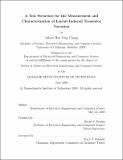A test structure for the measurement and characterization of layout-induced transistor variation
Author(s)
Chang, Albert Hsu Ting
DownloadFull printable version (5.961Mb)
Other Contributors
Massachusetts Institute of Technology. Dept. of Electrical Engineering and Computer Science.
Advisor
Duane S. Boning.
Terms of use
Metadata
Show full item recordAbstract
Transistor scaling has enabled us to design circuits with higher performance, lower cost, and higher density; billions of transistors can now be integrated onto a single die. However, this trend also magnifies the significance of device variability. In this thesis, we focus on the study of layout-induced systematic variation. Specifically, we investigate how pattern densities can affect transistor behavior. Two pattern densities are chosen in our design: polysilicon density and shallow-trench isolation (STI) density. A test structure is designed to study the systematic spatial dependency between transistors in order to determine the impact of different variation sources on transistor characteristics and understand the radius of influence that defines the neighborhood of shapes which play a part in determining the transistor characteristics. A more accurate transistor model based on surrounding layout details can be built using these results. The test structure is divided into six blocks, each having a different polysilicon density or STI density. A rapid change of pattern density between blocks is designed to emulate a step response for future modeling. The two pattern densities are chosen to reflect the introduction of new process technologies, such as strain engineering and rapid thermal annealing. The test structure is designed to have more than 260K devices under test (DUT). In addition to the changes in pattern density, the impact of transistor sizing, number of polysilicon fingers, finger spacing, and active area are also explored and studied in this thesis. Two different test circuits are designed to perform the measurement. (cont.) The first test circuit is designed to work with of-chip wafer probe testing equipment; the second test circuit is designed to have on-chip current measurement capabilities using a high dynamic range analog-to-digital converter (ADC). The ADC has a dynamic range of over four orders of magnitude to measure currents from 50nA to 1mA. The test chip also implements a hierarchical design with a minimum amount of peripheral circuitry, so that most of the chip area is dedicated for the transistors under test.
Description
Thesis (S.M.)--Massachusetts Institute of Technology, Dept. of Electrical Engineering and Computer Science, 2009. This electronic version was submitted by the student author. The certified thesis is available in the Institute Archives and Special Collections. Cataloged from student-submitted PDF version of thesis. Includes bibliographical references (p. 131-139).
Date issued
2009Department
Massachusetts Institute of Technology. Department of Electrical Engineering and Computer SciencePublisher
Massachusetts Institute of Technology
Keywords
Electrical Engineering and Computer Science.